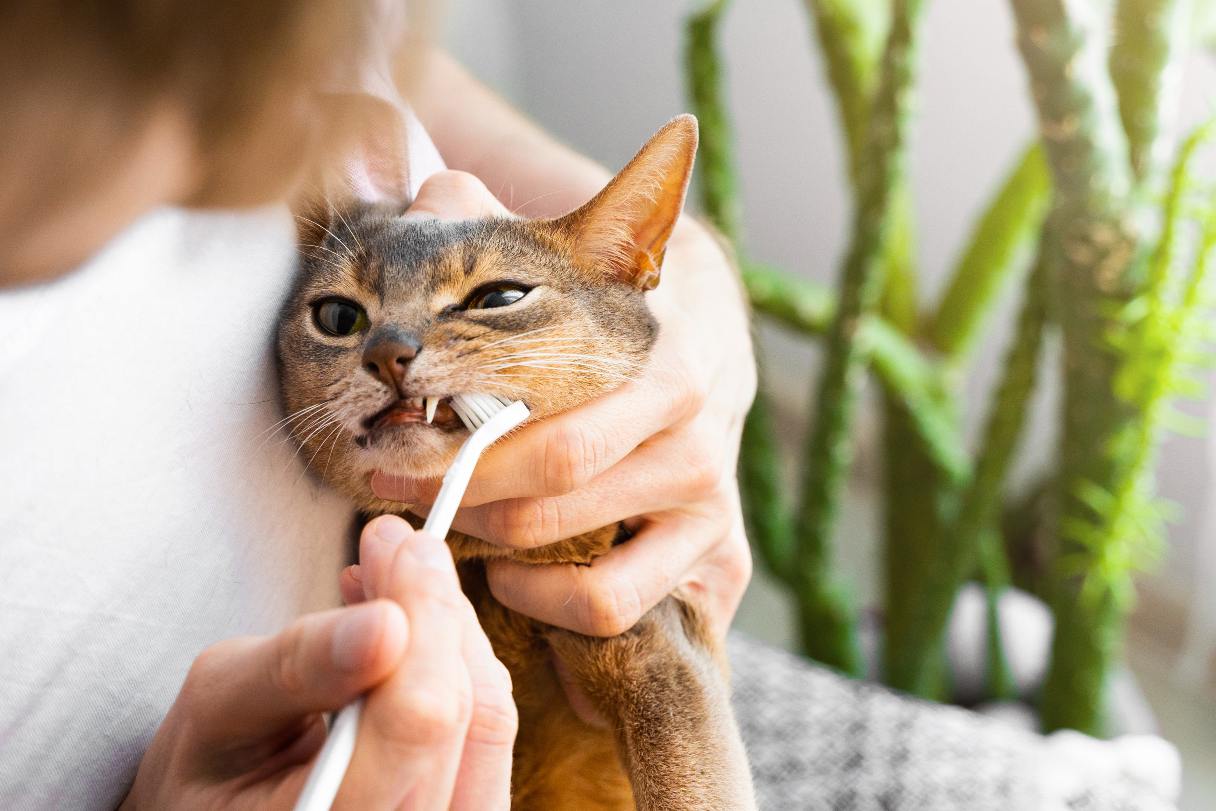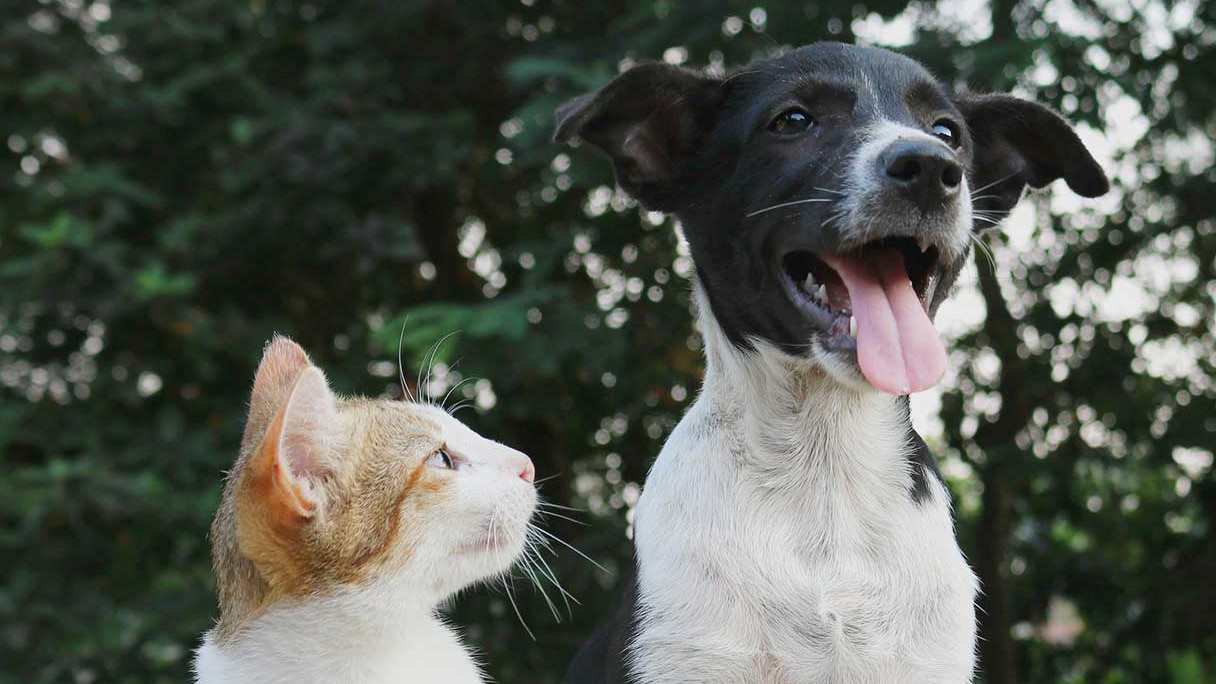Most cats develop periodontal disease by the time they’re 2 years old. Without regular tooth care, the accumulation of plaque and tartar can cause major dental issues for your kitty, including mouth pain, tooth fractures and tooth loss.1
With their dental health on the line, it’s easy to see why keeping your cat’s teeth clean should be a priority. Here are seven helpful tips to help you clean your cat’s teeth and maintain a healthy mouth.
1. Ease Your Cat Into Teeth Cleaning
Cats generally don’t take readily to having things poked inside their mouths. Whether you’re starting with a kitten or an adult cat, follow these steps to get your kitty used to the idea of having their teeth brushed:2
-
Pick a time when your kitty is feeling relaxed and happy.
-
Find a calm and quiet place where you can either set your cat on a counter or hold them comfortably but firmly in your lap. Shut the door and block off escape routes.
-
Dip a cotton swab in water from a can of tuna and let your kitty sniff and taste it.
-
Gently hold your cat’s head at a 45-degree angle and peel back their top lip. Rub the swab along the line where the teeth and gums meet.
-
Just do a few teeth at a time, practicing in short sessions and gradually increasing the amount of time and the surface covered.
-
Once your kitty lets you rub all of their teeth without struggling, they’ll be ready to let you brush them for real.
2. Use the Right Supplies
You have several options for tools to brush your cat’s teeth. These include:2
-
A commercially made cat toothbrush
-
A toothbrush for human babies
-
A finger toothbrush made for small pets
-
Gauze wrapped around your finger
-
A cotton swab
As for toothpaste, you should never use toothpaste made for humans, which contains ingredients that are toxic to pets. It’s also not a good idea to use baking soda, which is too alkaline for a cat’s stomach if swallowed. A toothpaste specially made for pets, which comes in flavors that are appetizing to cats and can be safely ingested, is the suitable option.2
3. Create a Positive Atmosphere
Help your kitty form positive associations with getting their teeth brushed. This requires you to stay calm and speak gently to your cat — and to stop if you find yourself getting frustrated. Reward their cooperation with lots of treats and praise. You can also try calming treats and toys to help make them more relaxed and cooperative.3 If your kitty is fearful or anxious, a pheromone diffuser, collar or spray may help them feel safe and calm.4
4. Brushing Your Cat’s Teeth
The actual toothbrushing will be similar to the practice sessions. Follow these steps to help make sure you give those teeth a thorough cleaning:2
-
Apply a bead of toothpaste to your chosen toothbrush.
-
In the place where you practiced, hold your kitty, tilt their head back and peel open their lips.
-
Focus mainly on brushing the front of the canines and the large teeth inside the cheek, which is where the buildup of plaque and tartar tends to be the worst. Don’t worry about getting the back of the teeth — your cat’s tongue will take care of the inner side.
-
As long as your cat is cooperating, work up to brushing all of the teeth at the front and back of the mouth.
-
Aim to brush for about 30 seconds on each side of the mouth.
5. Feed Them Dental Food and Treats
While not a good replacement for regular toothbrushing, dental treats and dental diets for cats can be an integral part of keeping your cat’s teeth clean and healthy. They work mainly by providing surfaces that help loosen and remove plaque as the cat chews. But some dental treats and cat food formulas also contain ingredients that inhibit plaque growth, help reduce tartar and kill harmful mouth bacteria.1
6. Use Other Alternatives or Additions to Brushing
Cat dental health products aren’t an effective substitute for regular brushing. However, if your kitty simply won’t cooperate with having their teeth brushed — or if you find it challenging to consistently make time for it — there are other products available that can help promote good oral health in cats. Enzymatic water additives are among these products, but the actual effectiveness of these is questionable, and some vets warn that they may make cats reluctant to drink water.1
Other options include topical gels that can be rubbed onto your cat’s teeth and antiseptic oral rinses designed to reduce odor and bacteria in your cat’s mouth.1 Additionally, there are toys available that encourage cats to chew and help clean teeth.5 Combined with the treats and food mentioned above, these can be an effective addition to your kitty’s daily oral hygiene routine.
7. Schedule Regular Dental Checkups and Cleanings
Plaque and tartar buildup can cause several health issues that sneak up on you and your kitty, so it’s important to have their teeth examined regularly by a veterinarian and to have their teeth professionally cleaned as needed. A professional teeth cleaning under anesthesia will allow your vet to remove plaque and tartar below the gumline that you can’t reach with a toothbrush. It’s the plaque embedded below the gums that is most responsible for periodontal disease, so it’s important to have it removed regularly.6
Signs Your Cat Has Dental Issues
Regular dental checkups can help your vet detect hidden dental problems, but if your cat displays any of these signs of possible dental issues, you should take them to the vet right away:7
-
Avoiding dry food
-
Eating slowly or taking longer to eat
-
Dropping food while trying to chew it
-
Drooling
-
Resisting face touches
-
Pawing at the mouth
-
Unusually bad breath
-
Swollen or bleeding gums8
Cleaning your cat’s teeth regularly takes time and effort, but it’s an important part of their daily care and upkeep. Not only will it help keep them healthier in the long run, but their fresh breath will make those kitty cuddles so much sweeter.
Frequently Asked Questions About Cat Teeth Cleaning
Do you still have questions about cleaning your cat's teeth? Here are some answers to commonly questions about cat teeth cleaning.
CareCredit Credit Card Financing for Cats
The CareCredit credit card is an easy way to pay for your cat’s annual checkups, food and products at veterinary practices in the CareCredit network.* Use our Acceptance Locator to find a veterinarian near you that accepts CareCredit to help keep your pet healthy and happy for a lifetime of love. CareCredit is there for you and your pet every step of the way; continue your wellness journey by downloading the CareCredit Mobile App to manage your account, find a provider on the go and easily access the Well U blog for more great articles, podcasts and videos.
In addition to pet care, you can also use your CareCredit credit card for dentistry, cosmetic, vision, hearing, health systems, dermatology, pharmacy purchases, spa treatments and so much more within the CareCredit network. How will you invest in your health and wellness next?
Author Bio
Jean Marie Bauhaus is a freelance writer and novelist who has been writing pet content since 2013. Her work has appeared on Forbes.com, Hill's Pet, Chewy, AKC.org and more.








